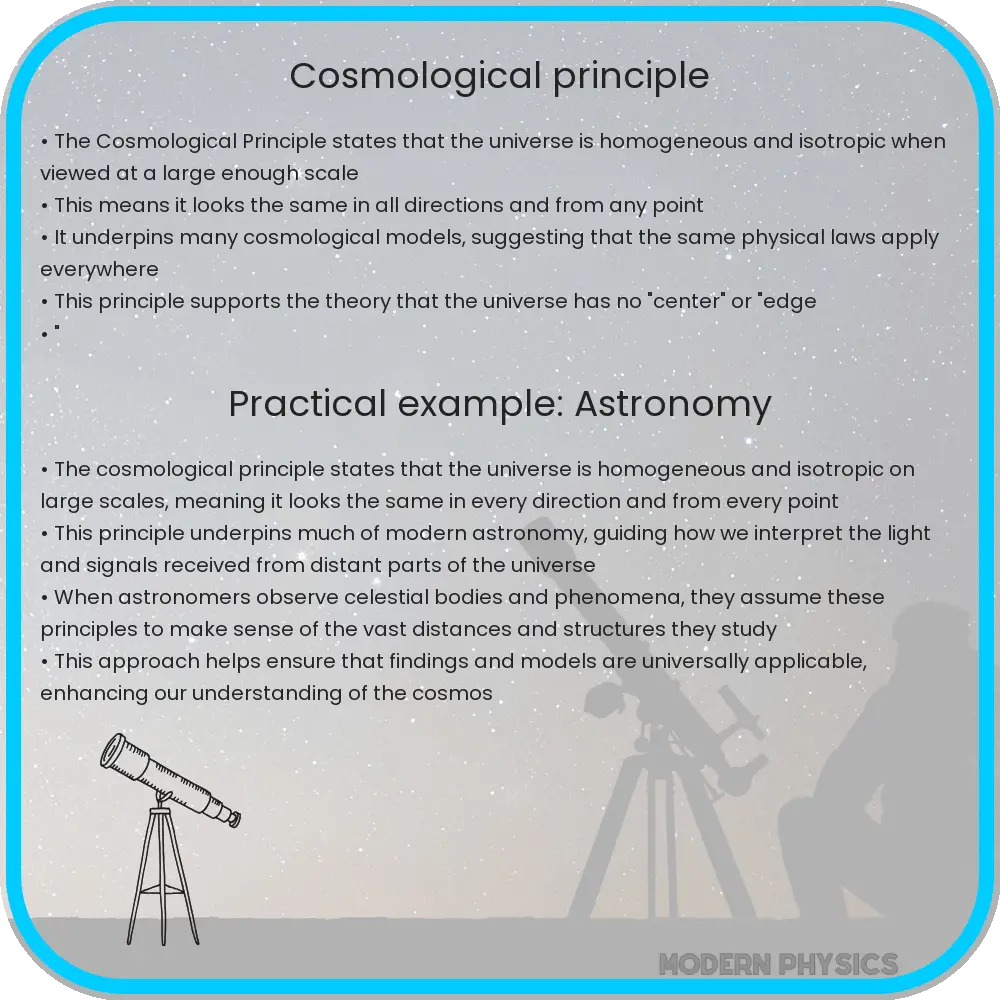Explore the Cosmological Principle, the idea that the universe is uniform and isotropic on large scales, shaping our understanding of its structure and evolution.

The Cosmological Principle: Understanding Universe’s Uniformity and Isotropy
The Cosmological Principle is a foundational concept in modern cosmology that suggests the universe is homogeneous and isotropic when viewed on a large scale. This means that, from any point in the universe, the distribution of matter and radiation appears the same in all directions, and there are no preferred locations or directions in the cosmos. This principle forms the basis for the development of cosmological models and our understanding of the universe’s structure and evolution.
Homogeneity: A Uniform Universe
Homogeneity implies that the universe has a uniform composition and structure when observed over large scales, typically hundreds of millions of light-years. At these distances, significant structures like galaxies, galaxy clusters, and superclusters become less distinct, and the universe appears more like a smooth, continuous distribution of matter. This concept does not negate the existence of local inhomogeneities, such as stars, planets, and galaxies, but suggests that these are distributed uniformly when viewed from a sufficiently large perspective.
Isotropy: The Universe’s Symmetry
Isotropy, on the other hand, refers to the universe appearing the same in all directions. Observational evidence supporting isotropy comes from the Cosmic Microwave Background (CMB) radiation, a relic from the early universe. The CMB is remarkably uniform in temperature, with slight fluctuations that are the same in all directions. This uniformity supports the idea that the universe was in a highly homogeneous and isotropic state shortly after the Big Bang.
Implications of the Cosmological Principle
The acceptance of the Cosmological Principle has profound implications for our understanding of the universe. It allows astronomers and cosmologists to simplify the complex equations governing the universe’s dynamics, leading to more tractable models that can be used to predict cosmic phenomena. Additionally, it sets the stage for the development of the Big Bang theory, providing a framework within which the evolution of the universe can be understood and studied.
Despite its fundamental role, the Cosmological Principle is based on observations and assumptions. As such, it is continually tested as we observe the universe at larger scales and with greater precision. The ongoing challenge for cosmologists is to determine whether the principle holds true in all cases or if there are exceptions that could lead to new understandings of the cosmos.
Testing the Cosmological Principle
The validity of the Cosmological Principle is tested through extensive astronomical observations and measurements. One of the primary tools for this testing is the study of the large-scale structure of the universe through galaxy surveys. These surveys assess the distribution of galaxies and galaxy clusters across vast volumes of space. While local variations and structures such as voids and filaments are evident, the overall distribution trends towards uniformity when viewed on scales larger than 300 million light-years.
Another critical set of observations comes from the study of the Cosmic Microwave Background (CMB) radiation. The Planck satellite and other CMB experiments have provided detailed maps of the CMB, revealing the slight temperature fluctuations that represent the early universe’s density variations. These fluctuations are statistically isotropic, supporting the notion that the universe was extremely uniform and isotropic shortly after the Big Bang.
Challenges and Future Directions
Despite the strong support for the Cosmological Principle, there are ongoing debates and challenges. Observations at the largest cosmic scales and recent studies of cosmic microwave background anisotropies have hinted at possible anomalies that could challenge the principle’s strictest interpretations. These include the alignment of large-scale cosmic structures and unexpected irregularities in the CMB temperature distribution. Future astronomical surveys and missions, such as the Euclid satellite and the Square Kilometer Array (SKA), are expected to provide even more detailed observations that will allow for a more stringent testing of the principle.
Conclusion
The Cosmological Principle is a cornerstone of modern cosmology, providing a foundation for our understanding of the universe’s large-scale structure and evolution. While observations support its assertions of homogeneity and isotropy on vast scales, cosmology remains a dynamic field with ongoing research and debates. The principle serves as a guiding hypothesis, shaping the questions we ask about the universe and the methods we use to explore them. As observational techniques improve and our view of the universe expands, we will continue to test and refine our cosmic models, ensuring that our understanding of the cosmos remains as accurate and comprehensive as possible.
In this ever-evolving journey of cosmic discovery, the Cosmological Principle stands as a testament to our quest for understanding the grand scale structure and dynamics of the universe. By adhering to this principle, we continue to unlock the mysteries of the cosmos, piece by piece, in our timeless pursuit of knowledge.
